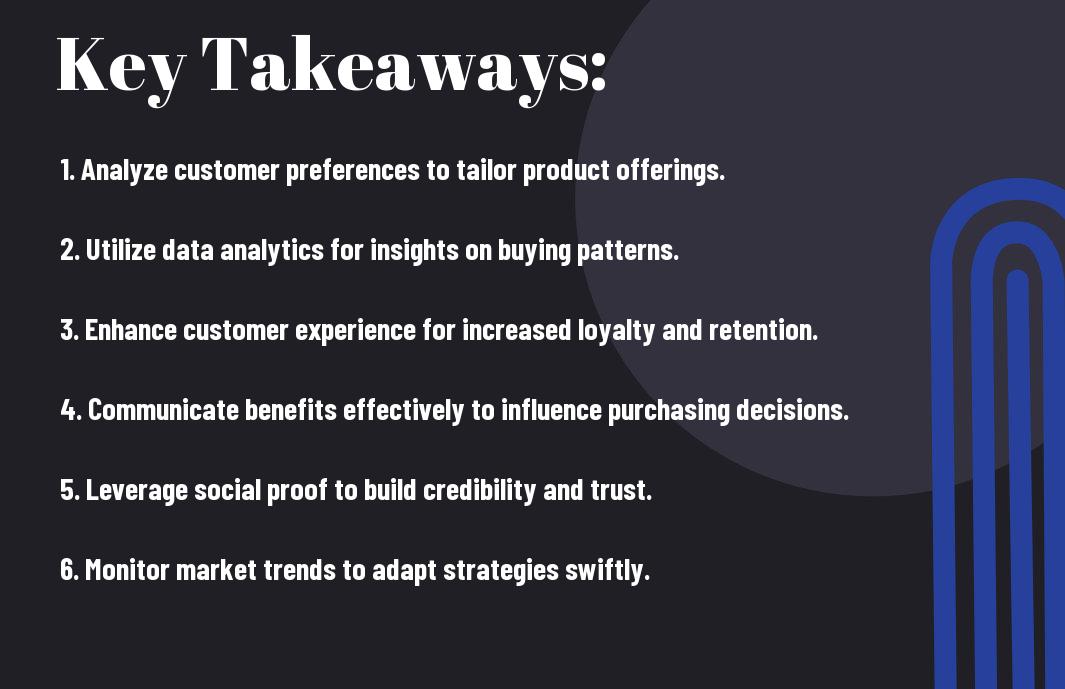
Consumer behavior insights can significantly influence your sales strategies and outcomes. By grasping what drives your customers’ decisions, you can tailor your marketing efforts and product offerings to meet their needs effectively. This knowledge empowers you to create compelling messages, enhance customer experiences, and ultimately increase your sales. In this post, you will explore key aspects of consumer behavior and practical approaches to leverage this understanding for your business success.

The Psychology of Consumer Behavior
The psychology of consumer behavior investigates into the underlying thoughts and feelings that drive your purchasing decisions. By understanding these complex processes, you can adjust your marketing strategies to better resonate with your target audience. Key psychological factors such as motivation, perception, and decision-making all play significant roles in how consumers interact with your brand and products.
Motivation and Needs
Behavior is often driven by various needs, ranging from basic requirements like food and safety to higher-level desires such as self-esteem and belonging. These motivations influence your buying patterns, as consumers seek products that fulfill their specific needs. By identifying and addressing these needs, you can effectively create targeted messages that resonate deeper with your audience.
Perception and Decision-Making
Needs shape your perception of products and influence your decision-making processes. The way you perceive value, quality, and brand reputation impacts how you assess options and, ultimately, make purchases. Your experiences, beliefs, and emotions filter information, affecting the likelihood of choosing your product over a competitor’s. As a marketer, understanding these perceptual filters allows you to strategize effectively and guide consumer choices.
The interplay between perception and decision-making highlights the importance of presenting information clearly and appealingly. You will want to consider how your audience interprets branding, advertising, and product features. Tailoring your messaging to align with consumer perceptions can encourage favorable decisions and strengthen brand loyalty. By addressing consumer needs and understanding how they perceive options, you position yourself to influence their choices positively.
The Role of Emotions in Shopping
While shopping may seem like a purely logical process, the reality is that emotions play a significant role in your purchasing decisions. Your feelings can influence what products you choose and when you decide to buy, ultimately shaping your overall shopping experience. Understanding how emotions impact your behavior can help you make more informed choices and enhance your interactions with brands.
Emotional Triggers and Responses
About understanding the emotional triggers that motivate you to shop is necessary for driving sales. Various factors such as nostalgia, happiness, or even anxiety can elicit specific responses that influence your choices. By recognizing these triggers, brands can tailor their marketing strategies to align with your emotional landscape, enhancing your shopping experience.
Creating Emotional Connections with Brands
The ability to create emotional connections with your preferred brands is a powerful aspect of consumer behavior. When brands resonate with your values and evoke positive feelings, you’re more likely to remain loyal and make repeat purchases. An emotional bond can encourage you to choose one brand over another, shaping your long-term purchasing habits.
For instance, consider how a brand’s storytelling can create vivid imagery that aligns with your personal experiences or aspirations. This connection can manifest in various ways, like through relatable advertising or community engagement, providing a sense of belonging. When brands make an effort to connect with you on an emotional level, they not only foster loyalty but also enhance your overall shopping experience, turning consumers into advocates.
Understanding Customer Segmentation
All businesses benefit from understanding customer segmentation. By dividing your target market into distinct groups based on shared characteristics, you can tailor your marketing efforts and product offerings to meet specific needs. This approach allows you to maximize your resources and improve customer engagement, ultimately leading to increased sales.
Demographic Segmentation
With demographic segmentation, you analyze factors like age, gender, income, education, and marital status. This information helps you identify preferences and purchasing behaviors unique to different demographic groups. By knowing who your customers are, you can create targeted promotions and communications that resonate with them, enhancing their overall experience with your brand.
Psychographic Segmentation
The psychographic segmentation process examines into the beliefs, values, interests, and lifestyles of your customers. Understanding these elements allows you to align your brand with their motivations, making your marketing more relatable and impactful.
Indeed, focusing on psychographic segmentation helps you go deeper than just demographics. It enables you to understand why customers make purchasing decisions and what drives their loyalty. By tapping into the emotional and psychological factors that motivate your target audience, you can create marketing messages that resonate on a personal level, fostering stronger connections and ultimately boosting sales.
The Impact of Social Influences
Not only do social influences shape your purchasing decisions, but they also create a complex web of interconnected relationships that can significantly affect consumer behavior. Understanding these influences can empower you to target your marketing efforts more effectively, building strong connections with your audience and ultimately boosting sales.
The Role of Family and Friends
By leveraging the opinions of family and friends, you tap into a powerful form of social proof. When loved ones endorse or recommend a product, their influence can greatly impact your purchasing decisions, compelling you to choose one brand over another based on the trust you place in them.
Social Media and Online Communities
To successfully engage with your audience, you must recognize the impact of social media and online communities on buying behavior. These platforms facilitate discussions, recommendations, and the sharing of experiences, all of which can shape your perception of products and services.
But the influence of social media is not just about what you see; it encompasses the interactions and relationships you build within online communities. User-generated content, reviews, and discussions can create a sense of belonging and validation. This sense is powerful in guiding your choices, as you often find yourself aligning with others who share similar values or interests, further affecting your buying behavior.
Consumer Trends and Market Dynamics
Keep in mind that understanding consumer trends and market dynamics is vital for leveraging your sales strategies effectively. As you navigate this ever-evolving landscape, staying attuned to shifts in consumer preferences and behaviors enables you to tailor your offerings and resonate with your target audience, ultimately driving growth and profitability.
The Rise of Conscious Consumerism
By focusing on sustainability and ethical practices, you can tap into the growing wave of conscious consumerism. Today’s consumers are increasingly aligned with brands that share their values, seeking products that not only satisfy their needs but also contribute positively to the environment and society. Aligning your brand with these principles can significantly enhance customer loyalty and trust.
The Influence of Technology
Consumerism has transformed dramatically with the rise of technology, shaping how you engage with your audience. From online shopping conveniences to social media interactions, technology has opened new avenues for connection and personalization in your marketing strategies.
Rise in digital communication and online shopping has empowered consumers, giving them greater access to information and influencing buying decisions. This includes product comparisons, reviews, and social media recommendations, which can impact your sales. Embracing technology allows you to create tailored experiences that meet the evolving expectations of consumers. By leveraging data analytics, you can better understand your audience’s behaviors, preferences, and trends, optimizing your strategies to drive sales effectively.
Strategies to Enhance Customer Engagement
Now is the time to implement effective strategies that will elevate your customer engagement. By leveraging innovative technologies and understanding what resonates with your audience, you can create memorable experiences that foster loyalty and encourage repeat purchases. Focus on building strong relationships by engaging with customers through various channels, ensuring that they feel valued and heard.
Personalization and Customer Experience
About enhancing your customer experience means prioritizing personalization. Tailoring your offerings based on individual preferences and behaviors demonstrates that you genuinely understand your customers’ needs. Utilize data analytics to create custom marketing campaigns and product recommendations, thereby bridging the gap between your brand and your audience, ultimately leading to increased sales and satisfaction.
Utilizing Feedback and Reviews
Below, recognizing the importance of feedback and reviews can significantly improve your business strategy. Encouraging your customers to share their experiences provides invaluable insights, enabling you to adjust your offerings to better satisfy their expectations. Engaging with reviews, both positive and negative, shows your commitment to customer satisfaction and can enhance your brand’s reputation.
But integrating feedback and reviews into your sales strategy goes beyond merely responding to comments. Actively analyzing trends in customer feedback lets you identify common pain points and areas for improvement, leading to informed decisions that refine your offerings. Moreover, showcasing positive reviews on your platforms not only builds credibility but also influences potential buyers, as they are more likely to trust peer recommendations over traditional advertising. By valuing feedback, you create a culture of transparency and engagement, ultimately fostering long-lasting relationships with your customers.
Final Words
From above, it is clear that understanding consumer behavior is imperative for enhancing your sales strategy. By putting yourself in your customers’ shoes and recognizing their needs, preferences, and decision-making processes, you can tailor your offerings more effectively. This insight allows you to create targeted marketing campaigns, improve customer experiences, and ultimately drive conversions. By continually analyzing and adapting to consumer trends, you position your business for sustainable growth and success in a competitive landscape.
Leave a Reply